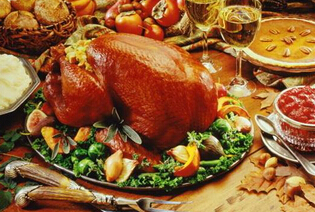For many, the turkey is one of the highlights of Thanksgiving. So why do we waste so much of it?
对许多人来说,火鸡是感恩节的亮点之一。那么,为什么我们会浪费这么多呢?
The U.S. Department of Agriculture estimates the country wastes 35 percent of all turkey meat over the course of the year. And it's not hard to guess the day it's cooked the most.
美国农业部估计,国家今年浪费了百分之三十五的火鸡肉。不难猜到火鸡烹饪最多的一天。

A lot of that waste ends up in landfills - a situation made worse by the greenhouse gases the food then releases into the atmosphere.
大量的垃圾最终被填埋,更糟糕的是废弃的食物会产生温室气体排放到大气中。
Supermarkets could be partly to blame. They've historically made turkey cheaper as Thanksgiving nears to get shoppers to buy the rest of the meal's ingredients and other impulse purchases from their stores as well.
部分原因归咎于超市。随着感恩节临近,他们历史性的降低火鸡价格让消费者购买一餐的原料,以及他们店里的其它东西。
Turkeys aren't only cheaper; they're bigger. Artificial insemination practices since the 1940s have now made the birds more than twice as big before slaughter than they were in the 1920s.
火鸡不仅便宜,而且很大。自20世纪40年代人工授精以来,火鸡比20世纪20年代的两倍还要大。
But a final reason for all the Thanksgiving overabundance, and waste in general, may be due to the best of intentions.
感恩节食物过多,大体浪费的最终原因可能是因为最好的意图。
A senior advocate at the Natural Resources Defense Council's Food and Agriculture Program told The Huffington Post a lot of overabundance comes from trying to accommodate guests' individual tastes and dietary restrictions.
美国自然资源保护委员会食品与农业项目资深律师告诉赫芬顿邮报,大量食物过剩源于满足客人的个人品味和饮食限制。
译文属可可原创,仅供学习交流使用,未经许可请勿转载。



